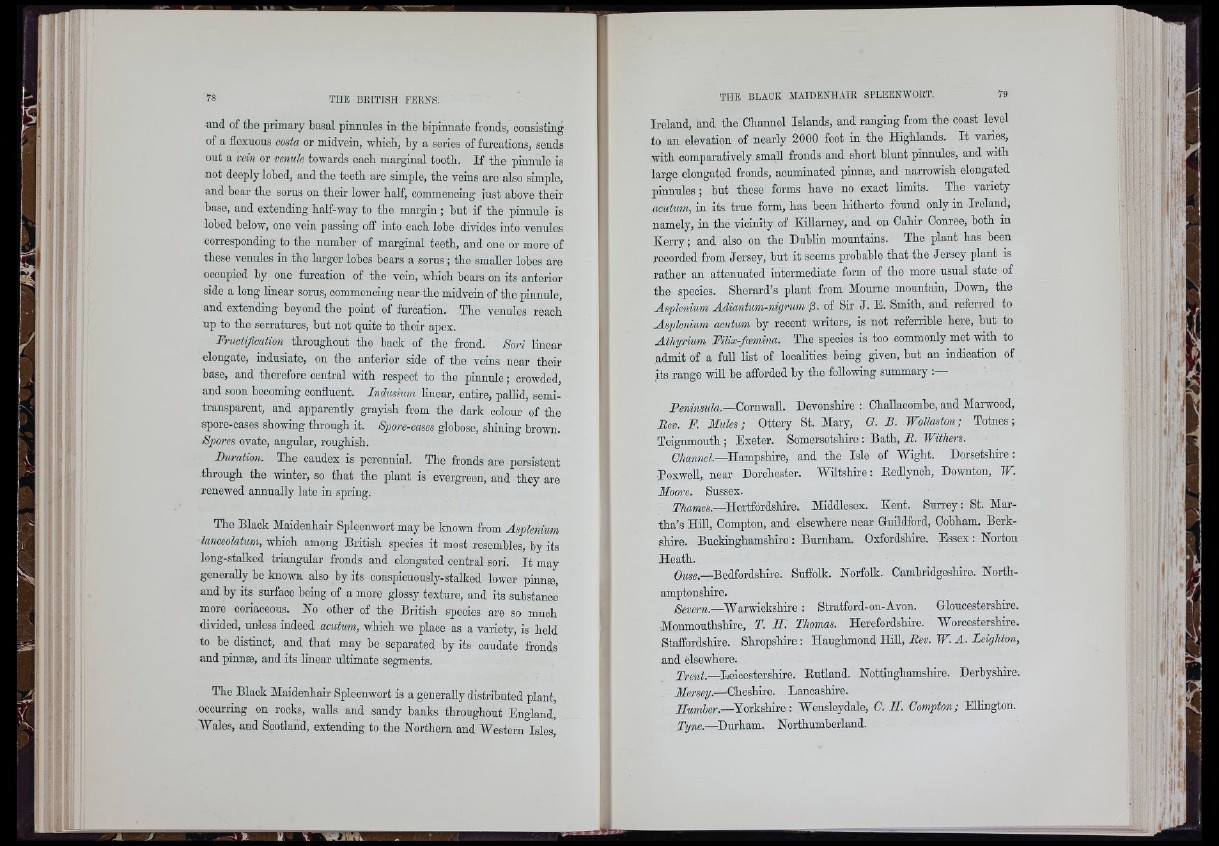
i 'fi
3 Ï
k
H r ■;
1 H
! :i
f -j
! L
rî
Uri
and of the primary basal pinnules in tho bipinnate fronds, consisting
of a flexuous costa or midvem, which, by a scries of furcations, sends
out a vein or venule towards each marginal tooth. I f the pinnule is
not deeply lobod, and tho teeth are simple, the veins are also simple,
and boar the sorus on their lower half, commencing iust above their
base, and extending half-way to tho margin ; but if the pinnule is
lobod below, one vein passing off into each lobe divides into venules
corresponding to the number of marginal teeth, and one or more of
those venules in the larger lobes bears a sorus ; the smaller lobes are
occupied by one furcation of the vein, which bears on its anterior
side a long linear sorus, commencing near the midvoin of the pinnule,
and extending beyond tho point of furcation. The venules reach
up to the serratui-es, but not quite to thoir apex.
Frnctificatwn throughout the back of the frond. 8ori linear
elongate, indusiate, on the anterior side of tho veins near their
base, and therefore central with respect to the pinnule ; crowded,
and soon becoming confluent. Indusium linear, entire, paUid, semitransparent,
and apparently grajdsh from the dark colour of tho
spore-cases showing through it. Spore-cases globose, shining brown.
Spores ovate, angular, rougbisb.
Duration. The caudex is perennial. The fronds are persistent
through the winter, so that the plant is evergreen, and they are
renewed annually late in spring.
The Black Maidenhair Spleenwort may be known from Asplenium
lanceolatum, which among British species it most resembles, by its
long-stalked triangular fronds and elongated central sori. It may
generally be known also by its conspicuously-stalked lower piunoe,
and by its surface being of a more glossy texture, and its substance
more coriaceous. No other of the British species are so much
divided, unless indeed acutum, which we place as a variety, is held
to be distinct, and that may be separated by its caudate fronds
and pinnæ, and its linear ultimate segments.
The Black Maidenhair Spleenwort is a generally distributed plant,
occurring on rooks, walls and sandy banks throughout England,'
Wales, and Scotland, extending to the Northern and Western Islesi
Ireland, and the Channel Islands, and ranging from the coast level
to an elevation of nearly 2000 feet in tho Highlands. It varies,
with comparatively small fronds and short blunt pinnules, and with
large elongated fronds, acuminated pinnæ, and narrowish elongated
pinnules ; but these forms have no exact limits. The variety
acutum, in its true form, has been hitherto found only in Ireland,
namely, in the vicinity of KiUamey, and on Cahir Conree, both in
Kerry ; and also on the Dubhn mountains. The plant has been
recorded from Jersey, but it seems probable that the Jersey plant is
rather an attenuated intermediate form of the more usual state of
the species. Sherard’s plant from Mourne mountain. Down, the
Asplenium Adiantum-nigrum ¡3. of Sir J . E. Smith, and referred to
Asplenium acutum by recent writers, is not referrible here, but to
Athyrium Filix-fcemim. The species is too commonly met with to
admit of a fuU list of localities being given, but an indication of
its range will be afforded by the foUowing summary
Peninsula.—Cornwall. Devonshire : ChaUaoombe, and Marwood,
Bev. F. Mules; Ottery St. Mary, G. P. Wollaston; Totnes ;
Teignmouth ; Exetor. Somersetshire : Bath, B. Withers.
Channel—Mampàma, and the Isle of Wight. Dorsetshire:
Boxwell, near Dorchester. Wiltshire: Eedlynch, Downton, W.
Moore. Sussex.
T/wmes.—Hertfordshire. Middlesex. Kent. Surrey: St. Martha’s
Hill, Compton, and elsewhere near Guildford, Cobham. Berkshire.
Buckinghamshire : Burnham. Oxfordshire. Essex : Norton
Heath.
Otise.—Bedfordshire. Suffolk. Norfolk. Cambridgeshire. Northamptonshire.
Severn.—^Warwickshire : Stratford-on-Avon. Gloucestershire.
Monmouthshire, T. E . Thomas. Herefordshire. Worcestershire.
Staffordshire. Shropshire : Haughmond Hill, Bev. W. A. Leighton,
and elsewhere.
Trent.—Leicestershire. Rutland. Nottinghamshire. Derbyshire.
Mersey.—Cheshire. Lancashire.
Humber.—^Yorkshire: Wensleydale, C. H. Compton; Ellington.
Tyne.—Durham. Northumberland.
(C-
! .H
I : I
I -•
■( !
y , .
■ 1«’f
•If'
'■'i;
i i